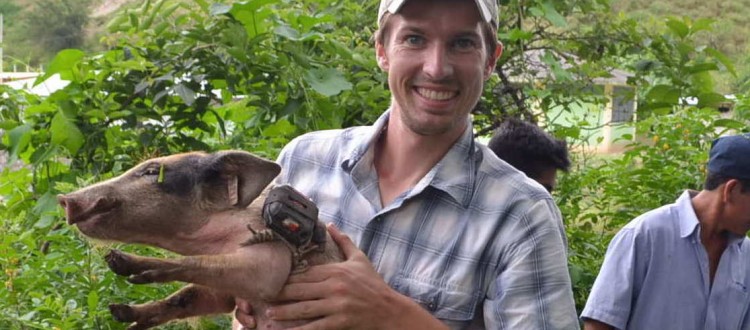Pigs, Tapeworms, and Epilepsy
For Ian Pray, those six weeks in Peru were more than a public health adventure.
Ian’s “field experience” in Peru changed the direction of his education career — and likely of his future.
Ian’s field experience, in a rural area of northern Peru, involved working with the School of Public Health’s Seth O’Neal, M.D., M.P.H. O’Neal does research on Taenia solium — a pork tapeworm that is a significant cause of preventable epilepsy in poor areas of Latin America, Asia and Africa.
In 2015, Ian was working on his Master of Public Health in Environmental Systems and Human Health at the School of Public Health and was hoping to do epidemiological research abroad for his field experience. He learned about O’Neal, met with him a couple of times and — with funding help from the School of Public Health — was able to get approval to work in the spring of 2015 with O’Neal’s team in rural areas around Tumbes, Peru.
O’Neal’s work focuses on developing a better understanding of how pigs and humans get infected with the parasite, and how to control the disease in poor rural communities that are heavily impacted. Humans get the intestinal tapeworm by eating undercooked pork that is infected with parasite cysts, and free-roaming pigs become infected by foraging on human feces. Humans can also become infected with tissue cysts through ingesting fecal contamination.
While the tapeworm infection in humans can be minor and cause no noticeable symptoms, eggs that spread from these tapeworm carriers can contaminate the environment and cause serious infection in family members and neighbors. This can include infection of the human brain, which is an important cause of seizures in these communities. The infection is one of the primary causes of adult onset epilepsy in the world. And the most severe problems happen most often in poor and rural areas, where there is no indoor plumbing and where pigs have access to human feces.
“It’s a major pubic health burden in these communities,” Ian says. “Brain scan studies have found that 20 percent or more of the people in communities we work in show signs of past infection in their brains – scars built up from a lifetime of exposure to this parasite.”
O’Neal’s team is working on a range of research on the tapeworm in areas around Tumbes. Ian’s field experience project focused on determining how wide an area the pigs roamed — which would then give researchers an idea about how and where the pigs could get infected.
Ian’s team attached GPS trackers to about 40 pigs and tracked their movements for two days. His findings confirmed what researchers had come to believe — that pigs in the region spend most of their time around the household environment, rummaging through garbage and ditches close to their owner’s homes. This suggests that infection most likely occurs in this home environment. Such findings can illustrate to the community the importance of keeping their pigs corralled to avoid exposure to feces. The small range that Ian discovered also helps guide strategies that target anti-parasitic treatment to the owners of infected pigs, who are more likely to be tapeworm carriers. Ultimately, the research can help guide future strategies that might prevent and control the tapeworm infections.
Afterwards, Ian was able to accomplish something that doesn’t often happen after field experiences: he published his research findings in a scientific journal — PLoS Neglected Tropical Diseases.
But the experience had a more lasting impact – on the direction of Ian’s education and future career. After earning his M.P.H., he accepted O’Neal’s offer to join his team as a Ph.D. researcher, doing more research work on the parasite. Ian returned to Peru in the spring of 2017, to do work to prepare for his Ph.D. dissertation, which will focus on more research on the tapeworm. Ian also learned in spring of 2017 that he won a Fulbright scholarship — which will provide him with a nine-month research fellowship that will enable him to do much of his Ph.D. research work while living and working near Tumbes.
Ian says his field experience galvanized his interest in designing his own research and participating in a project from start to finish — going out into the field himself to collect data and following it all the way through analysis and publication. And the experience not only taught him a lot; it changed almost everything for Ian.
“I wouldn’t be where I am today without having had that experience,” he says.

